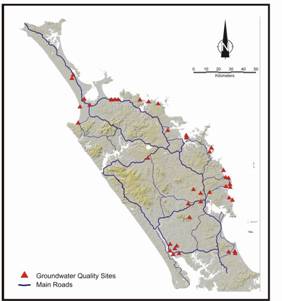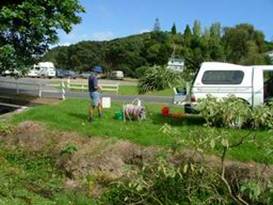Groundwater Quality Monitoring
Within this section…
 The Northland Regional Council participates in the National Groundwater Monitoring Programme (NGWMP), which is a joint project between the Institute of Geological and Nuclear Sciences (IGNS) and Regional Councils. The focus of this research is to determine national groundwater quality trends.
The Northland Regional Council participates in the National Groundwater Monitoring Programme (NGWMP), which is a joint project between the Institute of Geological and Nuclear Sciences (IGNS) and Regional Councils. The focus of this research is to determine national groundwater quality trends.
Seven sites are situated in Northland, and have been sampled every three months since September 1996. These sites are located at Houhora, Paparore, Ahipara, Kaikohe, Tutukaka, Glenbervie and Tara as shown on the map. Samples from each site are analysed for major cations, anions, nutrients and trace elements such as iron.
The Regional Council also operate a regional Groundwater Quality Monitoring Programme (GWQMP), which commenced in November 2002. The data gained from this monitoring will improve understanding of the region's groundwater aquifer system and help assess the sustainable management of the groundwater resources. The primary aim of the regional GWQMP is to gain a perspective on baseline water quality of the different aquifers in Northland and identify any trends in groundwater quality over time as a result of the climate, land use and groundwater abstraction.
As part of the regional GWQMP 29 sites are sampled (in addition to those sampled for the National Groundwater Monitoring Programme) on a three monthly basis. Twenty-two of these sites are located in coastal aquifers, which are analysed for saltwater and bacterial indicators every six months and chemical properties (the same set as for the national programme) on the sampling runs in between. Groundwater levels are also recorded at each site, where access is available. The remainder of the sites are located in basalt aquifers, these sites are sampled quarterly and analysed for a full range of determinants. All the GWQMP sites are listed in the table below.
| Coastal | General |
| Mangawhai Heads east Mangawhai Heads west Mangawhai Village Sandy Bay Taupo Bay Tauranga Bay Te Ngaire Bay Tapeka Point Pataua Bay Whananaki Bay Taiharuru Bay Ngunguru Whangaumu Beach Matapouri Bay Oakura Bay (2) Bland Bay Cable/Mangonui Bay Coopers Beach Waipapakauri Beach Waipapakauri East Houhora |
Maunu Basalt Whatitiri Basalt Three Mile Bush Basalt Matarau Basalt Glenbervie Basalt Kerikeri Basalt Maungakaramea Basalt |
Results of Groundwater Quality Monitoring
Groundwater quality in Northland is generally high enough that water can be consumed without treatment. Three areas of potential concern are contamination of groundwater resources by nitrate, bacteria and saltwater (saline). The median concentration of each determinant was calculated for each monitoring site and compared to the Maximum Allowable Values (MAVs) in the ‘The Drinking Water Standards for New Zealand' (Ministry of Health, 2005).
To view the ‘The Drinking Water Standards for New Zealand' (MoH 2005) refer to the Ministry of Health website: www.moh.govt.nz
The results from the NGWMP and regional groundwater quality monitoring programme indicate that concentrations of the majority of the determinants analysed are well below New Zealand drinking water limits in the aquifers monitored in Northland. However, 12 monitoring sites had median Iron (Fe) concentrations above the aesthetic guideline value for iron of 0.2 mg/L and 13 monitoring sites had median Manganese (Mn) concentration in excess of the aesthetic guideline value for Manganese of 0.04 mg/L. Out of 13 sites which exceed the Manganese aesthetic guidelines, only two sites had median Manganese concentrations above the Maximum Allowable Value for health reasons of 0.4 mg/L.
Most of the bores that have median Iron and Manganese concentrations in excess of aesthetic guideline values intersect groundwater in either basalt or fractured greywacke. High concentrations of Iron and Manganese are common in these rock types within the Northland region. Elevated levels in groundwater can cause staining of pipes and laundry.

Results of bacterial analysis indicate seven sites in both the coastal and the basalt groundwater systems were above the guideline value. Out of these seven sites three show repeated bacterial contamination in the last three sampling runs. This may be an indication of onsite wastewater contamination. It is important to note that the bacterial limit set in the ‘The Drinking Water Standards for New Zealand 2000' is 1 cfu/100 ml. Therefore any positive result for bacteria exceeds these drinking water standards.
Nitrate (NO3-) is considered a broad indicator of groundwater contamination from a variety of sources, including fertilisers, agricultural and human wastes. Nitrate is considered toxic in excessive concentrations. Bottle-fed infants are most at risk, as a high concentration of nitrate affects the ability of the blood to transfer oxygen. High nitrate concentrations in water and diet have been linked to some types of cancers.
The current New Zealand drinking water limit for nitrate is 11.3 mg L-1 (as NO3-N, taken from the ‘New Zealand Drinking Water Standards 2000'). Monitoring has shown that average nitrate concentrations at all NGWMP and regional network sites are well below this level. Nitrate concentrations are generally higher in the basalt bore than they are in the sands and other geology. This may be a result of the horticultural and agricultural land use in the areas surrounding the basalt aquifers. Elevated nitrate concentrations have been recorded in several sites in Taipa. The results of this monitoring are reported in the specific groundwater investigation (refer page 9) section.
Conductivity is an indirect measure of salinity. High levels may indicate salt-water intrusion as the result of lowering groundwater levels. Elevated conductivity values have been recorded at one site in the Ruawai area, which is discussed in the specific groundwater investigation (refer page 9) section. Bores monitored in Pataua North and Cable Bay also registered elevated chloride concentrations during the period of low groundwater levels in 2006. This is likely to be a direct result of the influence of saltwater.
In 2005-06, samples from all GWQMP bores were also analysed for Arsenic and Lithium. The results of this monitoring indicate Arsenic and Lithium concentrations are well below 'The Drinking Water Standards for New Zealand' (MoH 2005). Arsenic and lithium analysis will be conducted annually in the future.
The table below shows the median results for all the parameters tested for as part of the National Groundwater Quality Monitoring Programme since 1996.
| Parameter | Kaikohe | Paparore | Tara | Houhora | Ahipara | Glenbervie | Tutukaka |
| Alkalinity (mg/L) | 66 | 150 | 28 | 51.5 | 35 | 161 | 67 |
| Bromide (mg/L) | 0.1 | 0.18 | 0.085 | 0.325 | 0.1 | 0.06 | 0.56 |
| Calcium (mg/L) | 10.8 | 34 | 4.75 | 5.8 | 4.2 | 41.8 | 3.85 |
| Chloride (mg/L) | 10.7 | 52.5 | 17.9 | 32 | 33 | 14.7 | 117 |
| Conductivity (ms/m) | 17.7 | 41 | 14 | 21 | 18 | 32 | 58.6 |
| Fluoride (mg/L) | 0.03 | 0.0625 | 0.05 | 0.08 | 0.03 | 0.07 | 0.11 |
| Iron (mg/L) | < 0.02 | 0.06 | 0.35 | 1.4 | 1.4 | 0.05 | < 0.02 |
| Potassium (mg/L) | 1.5 | 2.8 | 1.55 | 1.5 | 1.7 | 1.5 | 2.9 |
| Magnesium (mg/L) | 6.2 | 5.7 | 4.1 | 3.8 | 3.4 | 6.1 | 7.85 |
| Manganese (mg/L) | < 0.005 | 0.12 | 0.01 | 0.06 | 0.04 | 0.006 | 0.007 |
| Sodium (mg/L) | 12.2 | 42 | 13.5 | 29.85 | 25.5 | 17.45 | 96 |
| Ammoniacal-N (mg/L) | < 0.01 | 0.06 | < 0.01 | 0.02 | 0.07 | < 0.01 | < 0.01 |
| Nitrate Nitrogen (mg/L) | 3 | 0.03 | 2.45 | 0.03 | 0.245 | 0.78 | 2.1 |
| pH | 6.6 | 7.85 | 6.4 | 6.6 | 6.4 | 7.3 | 6.8 |
| Silica (mg/L) | 41 | 41 | 24.5 | 40.25 | 36 | 25.4 | 33 |
| Sulphate (mg/L) | 2.9 | 8.75 | 2.8 | 8.7 | 6.75 | 10.8 | 27 |
